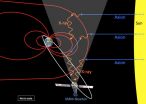(Press-News.org) MAYWOOD, Ill. (Oct. 16, 2014) -- As many as 35 percent of patients who undergo surgery to remove soft tissue sarcomas experience wound-healing complications, due to radiation they receive before surgery.
Now a study has suggested that a simple test called transcutaneous oximetry may be able to predict which of these patients are most likely to experience wound-healing complications, potentially enabling surgeons to take extra precautions.
Lukas Nystrom, MD, of Loyola University Medical Center presented his findings during the 2014 annual meeting of the Musculoskeletal Tumor Society. Dr. Nystrom received the society's "New Investigator Award" for the study.
Soft tissue sarcomas are cancers that originate in the soft tissues, such as muscles, fat, blood vessels, nerves and tendons. External beam radiation typically is part of the treatment regimen. Patients often do better, and require less radiation, when radiation is administered before surgery. But administering radiation before surgery also increases the risk of wound-healing complications.
Transcutaneous oximetry is a noninvasive test that measures the oxygen level of tissue beneath the skin. Adhesive sensors are placed on the skin; the sensors contain electrodes that can sense oxygen. The test causes no side effects or discomfort to the patient.
The study followed ten patients who underwent surgery for soft tissue sarcomas after receiving radiation treatment. Patients with lower transcutaneous oxygen levels before surgery were more likely to experience wound complications. Four of the seven patients who had levels lower than 25 mm Hg just before surgery experienced wound complications, while all three patients with oxygen levels higher than 25 mm Hg healed without difficulty.
Dr. Nystrom noted that the study population is small, and further work is necessary to confirm the findings. If confirmed by further study, transcutaneous oximetry potentially could become a tool to predict which patients are most at risk for wound complications. Extra precautions then could be taken to prevent complications, such as increasing the time interval between radiation and surgery and performing additional tissue transfers and vacuum-assisted closure, Dr. Nystrom said.
The study was performed at the University of Iowa Hospitals & Clinics, where Dr. Nystrom did his residency. The co-author is Benjamin Miller, MD of the University of Iowa.
"Transcutaneous oximetry represents a potential tool for decisions regarding surgical timing or potentially other medical and surgical efforts to diminish wound complications," Drs. Nystrom and Miller concluded. "However, given this small sample size, more data is needed to further assess the relationship."
Drs. Nystrom and Miller are applying for funding to conduct a prospective, multi-center study to confirm these findings. Loyola would serve as the primary study site.
INFORMATION:
Dr. Nystrom is an orthopaedic oncologist, specializing in the treatment of benign and malignant tumors of the bone and soft tissues. He is an assistant professor in the Department of Orthopaedic Surgery and Rehabilitation at Loyola University Chicago Stritch School of Medicine.
Simple test may predict surgical wound healing complications
Study done on patients with soft tissue sarcomas
2014-10-16
ELSE PRESS RELEASES FROM THIS DATE:
Should first responders use acupuncture & integrative medicine in natural disasters & battle zones?
2014-10-16
New Rochelle, NY, October 16, 2014—Delivering traditional emergency medical care at ground zero of natural disasters and military conflicts is challenging. First responders trained in simple integrative medicine approaches such as acupuncture, hypnosis, or biofeedback can provide adjunctive treatment to help relieve patients' pain and stress. How to teach and utilize modified techniques and their potential benefit are described in a Review article in Medical Acupuncture, a peer-reviewed journal from by Mary Ann Liebert, Inc., publishers. The article is available free ...
New study finds that the probability of unprotected intercourse in hookups doubles between freshman
2014-10-16
An article released by Social Forces titled, "Casual Contraception in Casual Sex: Life-Cycle Change in Undergraduates' Sexual Behavior in Hookups" by Jonathan Marc Bearak (New York University) explores the changes in undergraduate uncommitted sexual behavior during years 1–4 of college. The article provides reasoning for the decline in the use of condoms, and explains how changes in the odds of coitus and condom use depend on fam¬ily background, school gender imbalance, and whether the partners attend the same college.
The results show that the odds of unprotected ...
Dispelling a misconception about Mg-ion batteries
2014-10-16
Lithium (Li)-ion batteries serve us well, powering our laptops, tablets, cell phones and a host of other gadgets and devices. However, for future automotive applications, we will need rechargeable batteries with significant increases in energy density, reductions in cost and improvements in safety. Hence the big push in the battery industry to develop an alternative to the Li-ion technology.
One promising alternative would be a battery based on a multivalent ion, such as magnesium (Mg). Whereas a Li-ion with a charge of +1 provides only a single electron for an electrical ...
Myth-conceptions: How myths about the brain are hampering teaching
2014-10-16
Myths about the brain are common among teachers worldwide and are hampering teaching, according to new research.
Teachers in the UK, Holland, Turkey, Greece and China were presented with seven so-called 'neuromyths' and asked whether they believe them to be true.
A quarter or more of teachers in the UK and Turkey believe a student's brain would shrink if they drank less than six to eight glasses of water a day, while around half or more of those surveyed believe a student's brain is only 10 per cent active and that children are less attentive after sugary drinks and ...
First-ever patient care guidelines in prevention of acute exacerbations of COPD
2014-10-16
October 16, 2014, Glenview, Illinois—The American College of Chest Physicians (CHEST) and the Canadian Thoracic Society (CTS) announced today the release of Prevention of Acute Exacerbation of Chronic Obstructive Pulmonary Disease: American College of Chest Physicians and Canadian Thoracic Society Guideline in the journal CHEST. The guideline, a first of its kind, provides evidence-based recommendations aimed at prevention of COPD exacerbations, which can cause frequent hospital readmissions, death during or after a hospital stay, and can potentially greatly reduce ...
Survey: Texans share lessons learned as second enrollment period of ACA health insurance nears
2014-10-16
HOUSTON – (Oct. 16, 2014) – While most Texans used healthcare.gov earlier this year to get information or to enroll in a health insurance plan under the Affordable Care Act (ACA), larger percentages of Texans found talking to the call center or a navigator was the most helpful. Those are just some of the lessons learned in a report released today by the Episcopal Health Foundation and Rice University's Baker Institute for Public Policy.
The report found 62 percent of Texans used the healthcare.gov website to learn about ACA Marketplace health plans during ...
Light bending material facilitates the search for new particles
2014-10-16
Particle physicists have a hard time identifying all the elementary particles created in their particle accelerators. But now researchers at Chalmers University of Technology have designed a material that makes it much easier to distinguish the particles.
To investigate the matter's smallest constituents, physicists have particles colliding with each other at very high speeds, for example in the particle accelerator LHC at Cern. The collisions create bursts of common and rare particles, all invisible to the eye.
To identify them researchers need to detect the cone of ...
Cadavers beat computers for learning anatomy
2014-10-16
EAST LANSING, Mich. --- Despite the growing popularity of using computer simulation to help teach college anatomy, students learn much better through the traditional use of human cadavers, according to new research that has implications for health care.
Cary Roseth, associate professor of educational psychology at Michigan State University, said the study suggests cadaver-based instruction should continue in undergraduate human anatomy, a gateway course to medical school, nursing and other health and medical fields.
In the United States, most anatomy courses still emphasize ...
S-equol supplements associated with improved measures of reproductive health in postmenopausal women
2014-10-16
Northridge, Calif. (October 16, 2014) – Post-menopausal women experienced improvements in vaginal atrophy, with no significant effect on hormone levels or genital bleeding, after 12 weeks of daily 10 milligram (mg) doses of an investigational fermented soy germ-based nutritional supplement previously shown to help relieve certain menopause symptoms, according to a new peer-reviewed pilot study reported in a poster at the North American Menopause Society (NAMS) annual scientific meeting.
"These data documented improved vaginal epithelium, without significant abnormalities ...
Curious signal hints at dark matter
2014-10-16
Space scientists at the University of Leicester have detected a curious signal in the X-ray sky – one that provides a tantalising insight into the nature of mysterious Dark Matter.
The Leicester team has found what appears to be a signature of 'axions', predicted 'Dark Matter' particle candidates – something that has been a puzzle to science for years.
In a study being published on Monday 20 October in the Monthly Notices of the Royal Astronomical Society, the University of Leicester scientists describe their finding of a signal which has no conventional ...
LAST 30 PRESS RELEASES:
Statins significantly reduce mortality risk for adults with diabetes, regardless of cardiovascular risk
Brain immune cells may drive more damage in females than males with Alzheimer’s
Evidence-based recommendations empower clinicians to manage epilepsy in pregnancy
Fungus turns bark beetles’ defenses against them
There are new antivirals being tested for herpesviruses. Scientists now know how they work
CDI scientist, colleagues author review of global burden of fungus Candida auris
How does stroke influence speech comprehension?
B cells transiently unlock their plasticity, risking lymphoma development
Advanced AI dodel predicts spoken language outcomes in deaf children after cochlear implants
Multimodal imaging-based cerebral blood flow prediction model development in simulated microgravity
Accelerated streaming subgraph matching framework is faster, more robust, and scalable
Gestational diabetes rose every year in the US since 2016
OHSU researchers find breast cancer drug boosts leukemia treatment
Fear and medical misinformation regarding risk of progression or recurrence among patients with breast cancer
Glucagonlike peptide-1 receptor agonists and asthma risk in adolescents with obesity
Reviving dormant immunity: Millimeter waves reprogram the immunosuppressive microenvironment to potentiate immunotherapy without obvious side effects
Safety decision-making for autonomous vehicles integrating passenger physiological states by fNIRS
Fires could emit more air pollution than previously estimated
A new way to map how cells choose their fate
Numbers in our sights affect how we perceive space
SIMJ announces global collaborative book project in commemoration of its 75th anniversary
Air pollution exposure and birth weight
Obstructive sleep apnea risk and mental health conditions among older adults
How talking slows eye movements behind the wheel
The Ceramic Society of Japan’s Oxoate Ceramics Research Association launches new international book project
Heart-brain connection: international study reveals the role of the vagus nerve in keeping the heart young
Researchers identify Rb1 as a predictive biomarker for a new therapeutic strategy in some breast cancers
Survey reveals ethical gaps slowing AI adoption in pediatric surgery
Stimulant ADHD medications work differently than thought
AI overestimates how smart people are, according to HSE economists
[Press-News.org] Simple test may predict surgical wound healing complicationsStudy done on patients with soft tissue sarcomas




